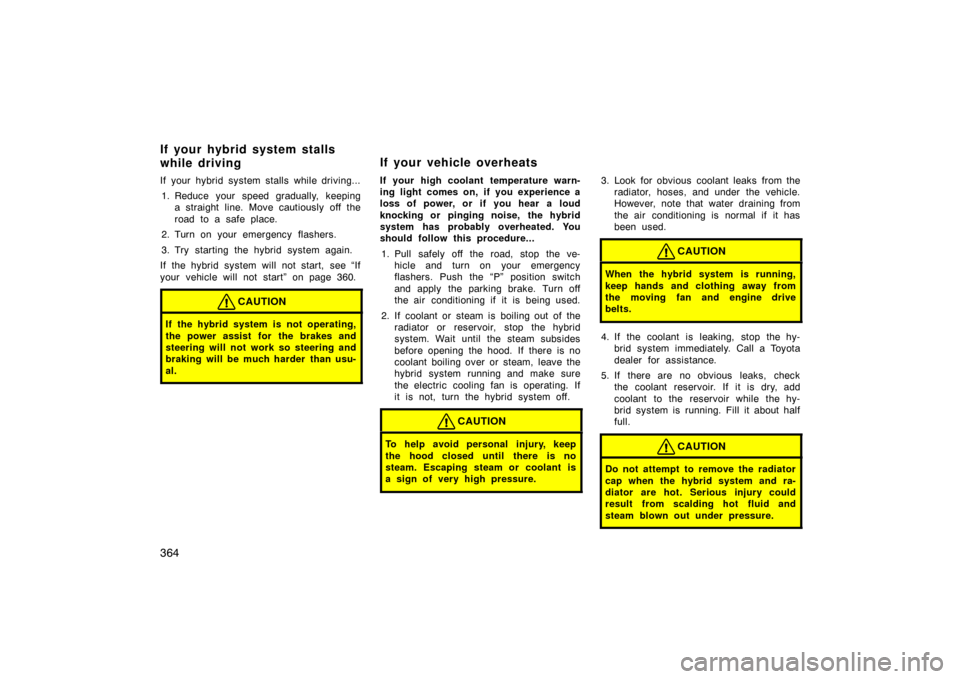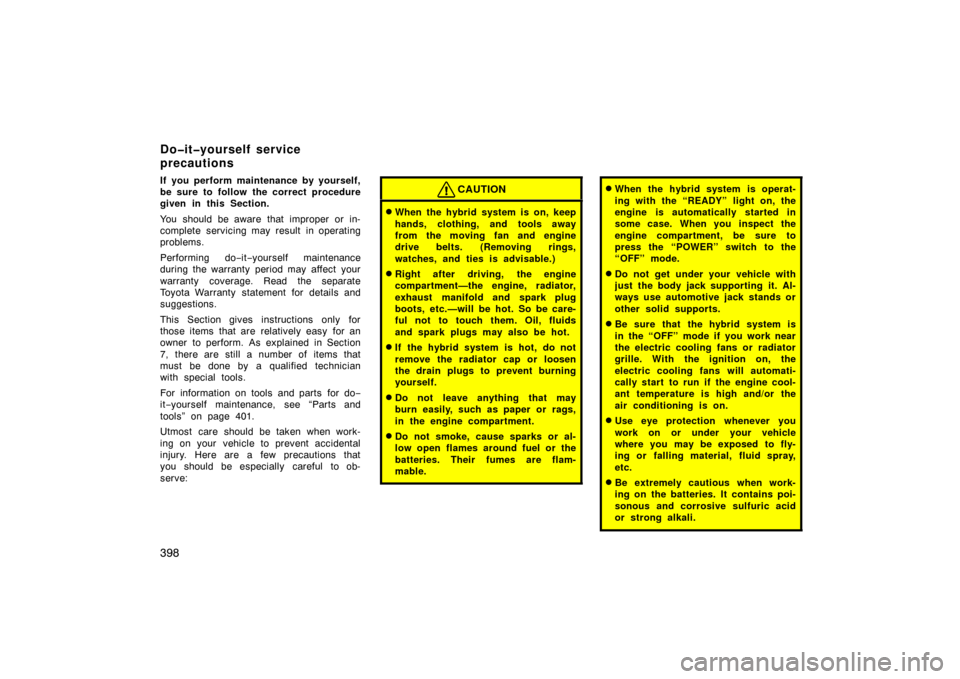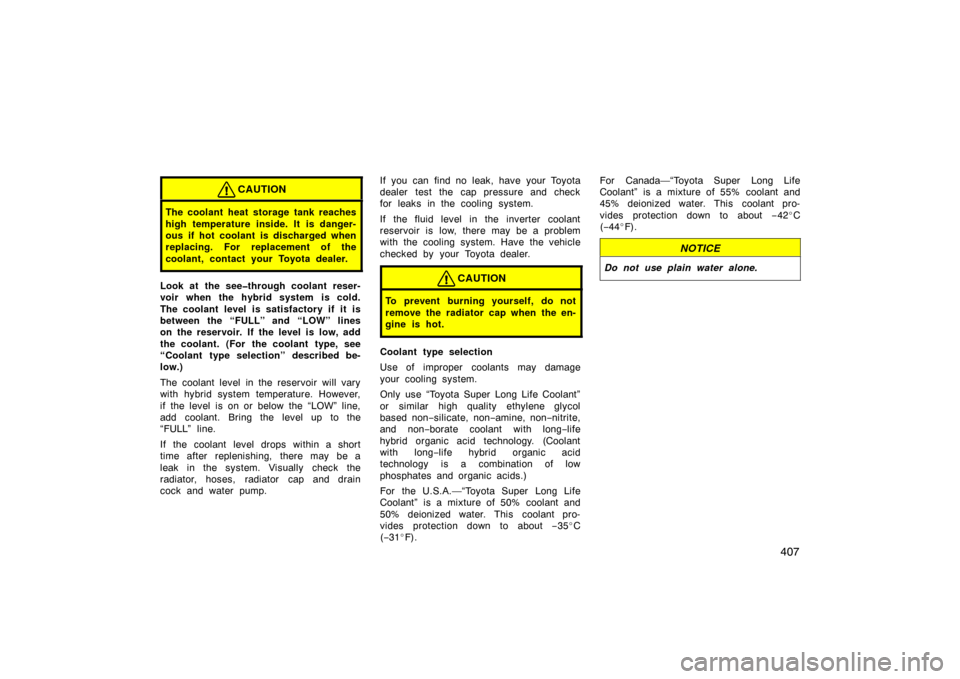Page 364 of 458

364
If your hybrid system stalls while driving...1. Reduce your speed gradually, keeping a straight line. Move cautiously off the
road to a safe place.
2. Turn on your emergency flashers.
3. Try starting the hybrid system again.
If the hybrid system will not start, see “If
your vehicle will not start” on page 360.
CAUTION
If the hybrid system is not operating,
the power assist for the brakes and
steering will not work so steering and
braking will be much harder than usu-
al.
If your high coolant temperature warn-
ing light comes on, if you experience a
loss of power, or if you hear a loud
knocking or pinging noise, the hybrid
system has probably overheated. You
should follow this procedure...
1. Pull safely off the road, stop the ve- hicle and turn on your emergency
flashers. Push the “P” position switch
and apply the parking brake. Turn off
the air conditioning if it is being used.
2. If coolant or steam is boiling out of the radiator or reservoir, stop the hybrid
system. Wait until the steam subsides
before opening the hood. If there is no
coolant boiling over or steam, leave the
hybrid system running and make sure
the electric cooling fan is operating. If
it is not, turn the hybrid system off.
CAUTION
To help avoid personal injury, keep
the hood closed until there is no
steam. Escaping steam or coolant is
a sign of very high pressure.
3. Look for obvious coolant leaks from theradiator, hoses, and under the vehicle.
However, note that water draining from
the air conditioning is normal if it has
been used.
CAUTION
When the hybrid system is running,
keep hands and clothing away from
the moving fan and engine drive
belts.
4. If the coolant is leaking, stop the hy-brid system immediately. Call a Toyota
dealer for assistance.
5. If there are no obvious leaks, check the coolant reservoir. If it is dry, add
coolant to the reservoir while the hy-
brid system is running. Fill it about half
full.
CAUTION
Do not attempt to remove the radiator
cap when the hybrid system and ra-
diator are hot. Serious injury could
result from scalding hot fluid and
steam blown out under pressure.
If your hybrid system stalls
while driving If your vehicle overheats
Page 396 of 458
396
Engine compartment overview
1. Windshield washer fluid tank
2. Brake fluid reservoir
3. Engine oil filler cap
4. Engine coolant reservoir
5. Inverter coolant reservoir
6. Fuse block
7. Radiator and condenser
8. Engine oil level dipstick
9. 12 volt battery(in luggage compartment)
81p001g
Page 398 of 458

398
If you perform maintenance by yourself,
be sure to follow the correct procedure
given in this Section.
You should be aware that improper or in-
complete servicing may result in operating
problems.
Performing do−it−yourself maintenance
during the warranty period may affect your
warranty coverage. Read the separate
Toyota Warranty statement for details and
suggestions.
This Section gives instructions only for
those items that are relatively easy for an
owner to perform. As explained in Section
7, there are still a number of items that
must be done by a qualified technician
with special tools.
For information on tools and parts for do −
it −yourself maintenance, see “Parts and
tools” on page 401.
Utmost care should be taken when work-
ing on your vehicle to prevent accidental
injury. Here are a few precautions that
you should be especially careful to ob-
serve:CAUTION
�When the hybrid system is on, keep
hands, clothing, and tools away
from the moving fan and engine
drive belts. (Removing rings,
watches, and ties is advisable.)
�Right after driving, the engine
compartment—the engine, radiator,
exhaust manifold and spark plug
boots, etc.—will be hot. So be care-
ful not to touch them. Oil, fluids
and spark plugs may also be hot.
�If the hybrid system is hot, do not
remove the radiator cap or loosen
the drain plugs to prevent burning
yourself.
�Do not leave anything that may
burn easily, such as paper or rags,
in the engine compartment.
�Do not smoke, cause sparks or al-
low open flames around fuel or the
batteries. Their fumes are flam-
mable.
�When the hybrid system is operat-
ing with the “READY” light on, the
engine is automatically started in
some case. When you inspect the
engine compartment, be sure to
press the “POWER” switch to the
“OFF” mode.
�Do not get under your vehicle with
just the body jack supporting it. Al-
ways use automotive jack stands or
other solid supports.
�Be sure that the hybrid system is
in the “OFF” mode if you work near
the electric cooling fans or radiator
grille. With the ignition on, the
electric cooling fans will automati-
cally start to run if the engine cool-
ant temperature is high and/or the
air conditioning is on.
�Use eye protection whenever you
work on or under your vehicle
where you may be exposed to fly-
ing or falling material, fluid spray,
etc.
�Be extremely cautious when work-
ing on the batteries. It contains poi-
sonous and corrosive sulfuric acid
or strong alkali.
Do�it�yourself service
precautions
Page 407 of 458

407
CAUTION
The coolant heat storage tank reaches
high temperature inside. It is danger-
ous if hot coolant is discharged when
replacing. For replacement of the
coolant, contact your Toyota dealer.
Look at the see�through coolant reser-
voir when the hybrid system is cold.
The coolant level is satisfactory if it is
between the “FULL” and “LOW” lines
on the reservoir. If the level is low, add
the coolant. (For the coolant type, see
“Coolant type selection” described be-
low.)
The coolant level in the reservoir will vary
with hybrid system temperature. However,
if the level is on or below the “LOW” line,
add coolant. Bring the level up to the
“FULL” line.
If the coolant level drops within a short
time after replenishing, there may be a
leak in the system. Visually check the
radiator, hoses, radiator cap and drain
cock and water pump.If you can find no leak, have your Toyota
dealer test the cap pressure and check
for leaks in the cooling system.
If the fluid level in the inverter coolant
reservoir is low, there may be a problem
with the cooling system. Have the vehicle
checked by your Toyota dealer.CAUTION
To prevent burning yourself, do not
remove the radiator cap when the en-
gine is hot.
Coolant type selection
Use of improper coolants may damage
your cooling system.
Only use “Toyota Super Long Life Coolant”
or similar high quality ethylene glycol
based non
−silicate, non −amine, non −nitrite,
and non− borate coolant with long −life
hybrid organic acid technology. (Coolant
with long −life hybrid organic acid
technology is a combination of low
phosphates and organic acids.)
For the U.S.A.—“Toyota Super Long Life
Coolant” is a mixture of 50% coolant and
50% deionized water. This coolant pro-
vides protection down to about −35 \bC
( − 31 \bF). For Canada—“Toyota Super Long Life
Coolant” is a mixture of 55% coolant and
45% deionized water. This coolant pro-
vides protection down to about
−42 \bC
( − 44 \bF).
NOTICE
Do not use plain water alone.